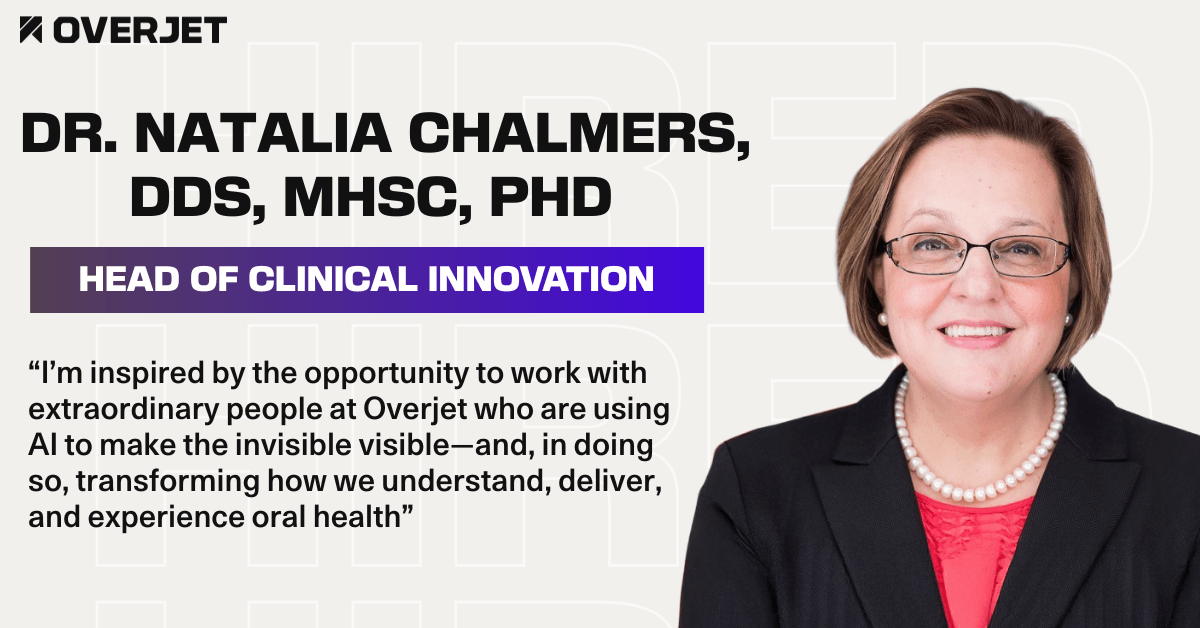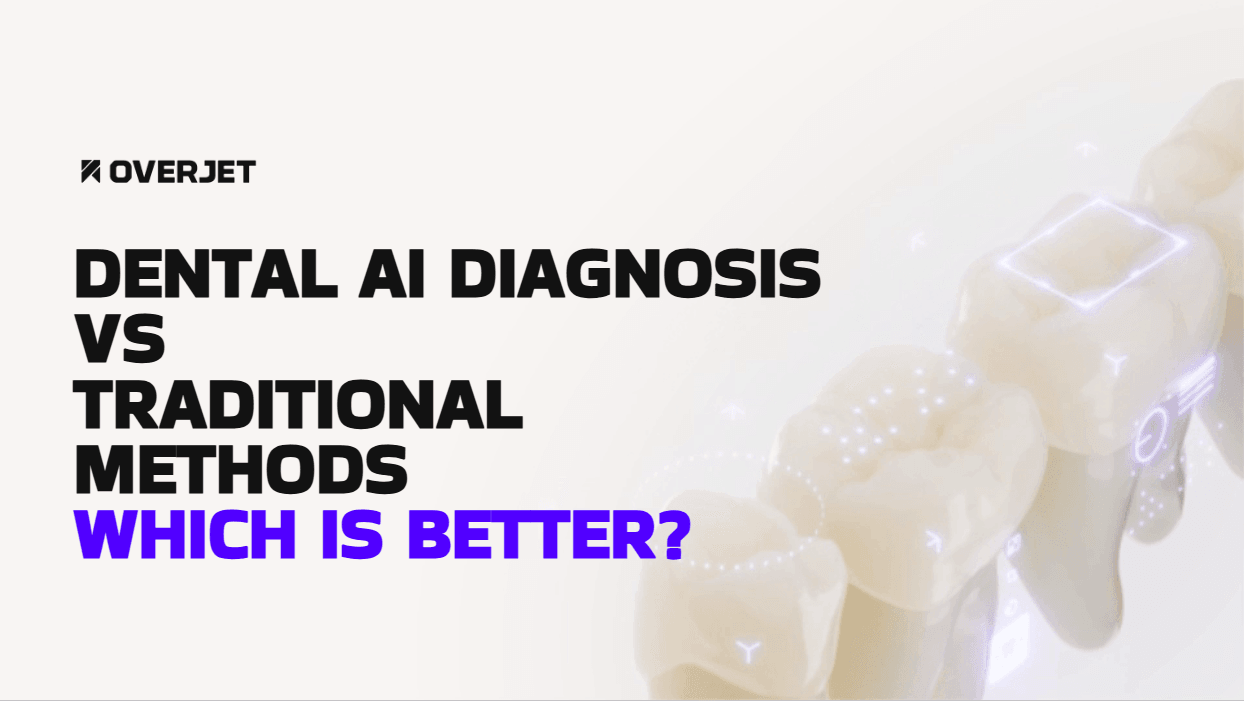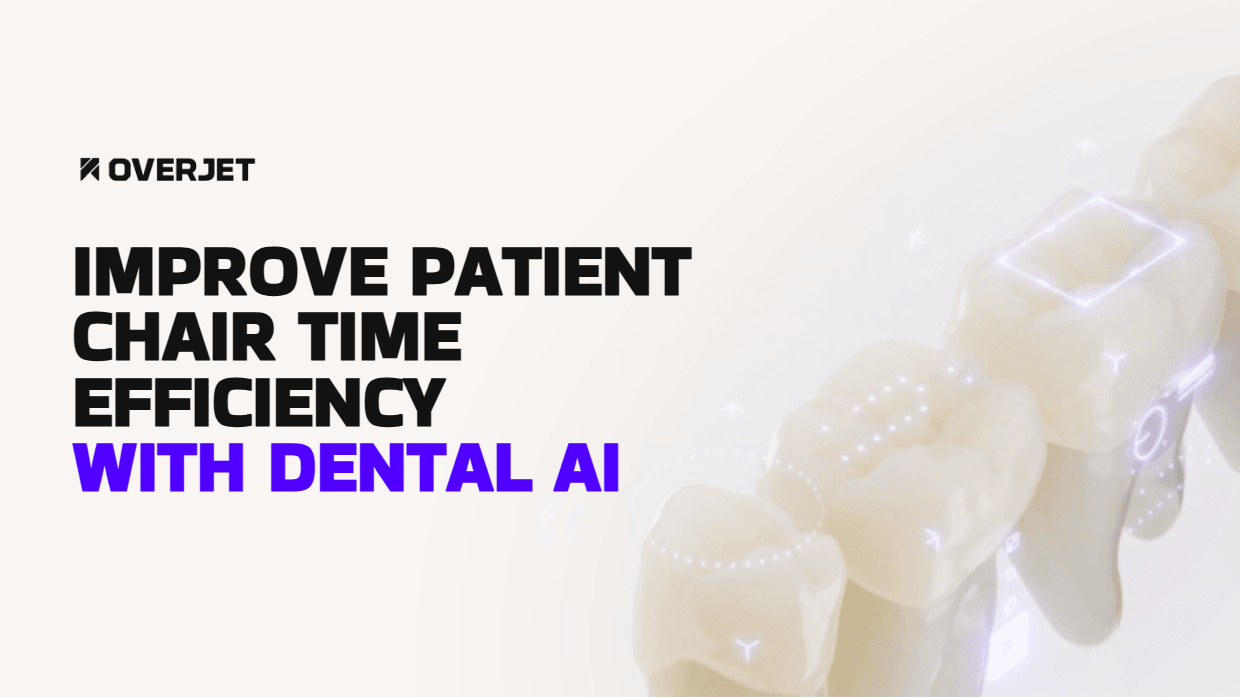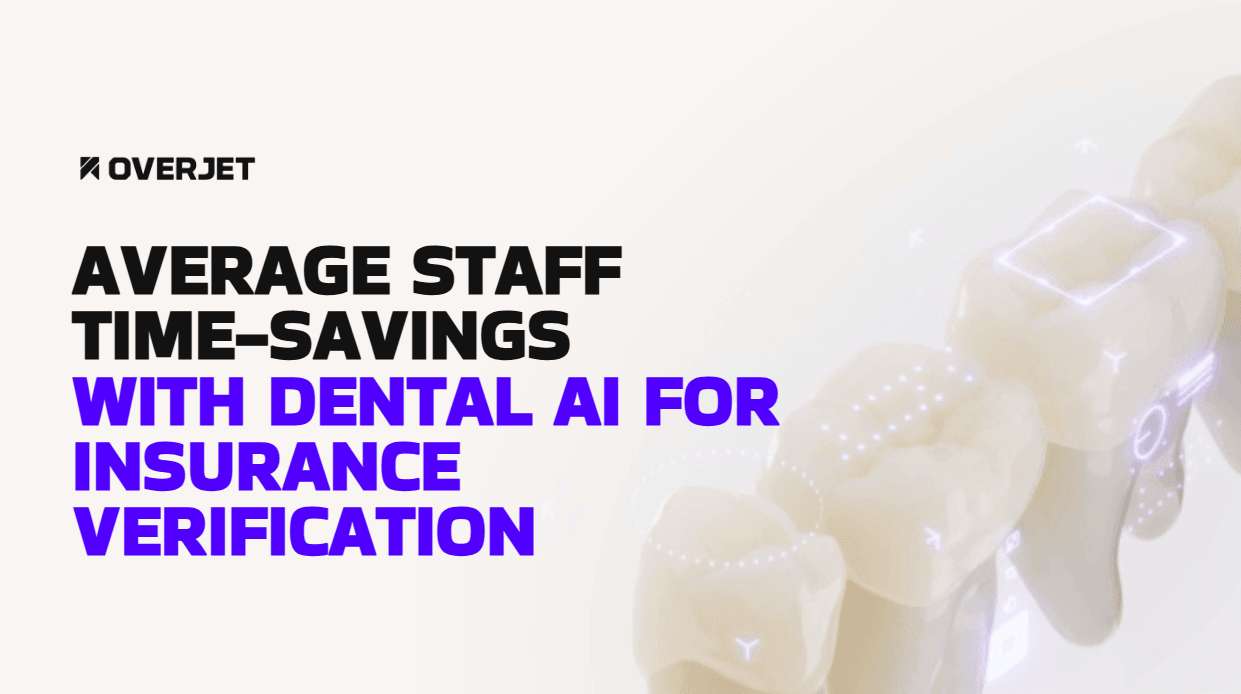Insurance verification consumes 10 to 15 minutes per patient when handled manually, yet automated systems complete the same task in seconds—a difference that transforms practice efficiency but introduces new considerations around cost, integration, and workflow changes. Dental practices evaluating automation face a decision that impacts everything from staff productivity to claim acceptance rates.
This guide examines the concrete advantages and genuine limitations of automated dental insurance verification, covering implementation strategies, essential features, performance metrics, and how platforms like Overjet integrate eligibility checking with clinical AI to create unified practice workflows.
Explore Overjet's Dental AI Software
What Automated Dental Insurance Verification Means Today
Automated dental insurance verification connects practice management systems directly to insurance databases, checking patient eligibility and benefits in real-time without phone calls. The software queries coverage details—deductibles, annual maximums, procedure-specific benefits—and returns answers in seconds rather than the 10 to 15 minutes staff typically spend navigating phone trees and waiting on hold. Manual verification requires calling insurance companies, logging into multiple web portals, and transcribing information by hand, while automation handles the same task instantly through digital connections.
The technology works through clearinghouses that maintain relationships with hundreds of insurance carriers. When a front-desk team member opens a patient record, the system pulls demographic information, sends a query to the clearinghouse, and receives back detailed benefit information that populates the patient chart automatically.
Why Manual Verification Fails Dental Practices
Manual insurance verification creates bottlenecks that slow down operations and increase costs. Staff members spend hours each day on verification calls, and the process introduces errors that lead to claim denials weeks after treatment.
Increased Administrative Costs
A typical verification call takes 10 to 15 minutes per patient when accounting for phone navigation, hold times, and recording information. For a practice seeing 30 patients daily, that adds up to five to seven hours of staff time spent exclusively on insurance calls. When verification requires multiple attempts due to busy lines or incomplete responses, those labor costs multiply further.
Higher Error Rates and Denials
Transcription mistakes happen frequently during phone verifications, particularly with complex coverage involving dual insurance or procedure-specific limitations. A single misheard digit in a deductible amount or confusion about frequency limits can trigger claim denials that require administrative rework and delay payment by weeks or months.
Delayed Patient Check-In Times
Front-desk staff juggle verification calls while simultaneously greeting arriving patients, answering phones, and managing schedules. Patients wait to hear about coverage before receiving treatment estimates, which creates frustration and sometimes leads to rescheduled appointments. The bottleneck impacts first impressions and can affect whether patients return for recommended care.
Key Pros of Automated Insurance Eligibility Checks
Automation addresses the core problems of manual verification while introducing capabilities that improve how practices manage revenue and communicate with patients. The advantages extend beyond time savings to fundamentally change administrative workflows.
Real-time benefit confirmation: Staff access patient-specific coverage instantly, including deductibles, maximums, frequency limitations, and procedure codes
Batch processing capabilities: Systems verify an entire day’s schedule overnight, so teams arrive each morning with complete eligibility data already in patient records
Reduction in claim denials: Verified, current eligibility data leads to cleaner claims that get accepted on first submission
Greater staff productivity: Teams redirect hours previously spent on phone calls toward treatment coordination and patient education
Improved patient satisfaction: Accurate financial discussions happen before treatment, eliminating surprise bills
Overjet’s platform integrates eligibility data with AI-powered diagnostic capabilities, allowing practices to present treatment plans with precise insurance estimates during the same patient visit. When benefit information flows directly into clinical workflows, case presentation becomes more confident and acceptance rates improve.
According to Overjet’s internal analysis of partner practices, clean claims—those accepted on first submission without errors—are consistently higher post-automation.
Hidden Cons and Limitations to Watch
Automated verification delivers substantial benefits, yet practices considering implementation face real challenges that deserve honest discussion. Setting appropriate expectations helps avoid disappointment and prepares teams for obstacles.
Upfront Subscription and Integration Costs
Monthly subscription fees typically range from $200 to $800 depending on practice size and features, with additional implementation costs for system integration and training. Smaller practices or those with tight cash flow may find the initial investment challenging, though return on investment typically occurs within six to twelve months. Integration with existing practice management systems can require technical support and one-time setup fees.
Payer Data Gaps and Exceptions
Not all insurance plans participate in electronic eligibility networks. Some Medicaid programs, smaller regional carriers, and certain specialty dental plans still require manual verification. Complex coverage scenarios—orthodontic benefits, implant coverage, or plans with unusual limitations—may need human interpretation even when automated systems return basic eligibility data. Most practices still manually verify approximately 5 to 10% of patients whose plans are not fully supported.
Training and Change Management
Staff members accustomed to manual processes sometimes resist new technology or struggle with workflow changes during transitions. The learning curve varies by team, though most practices experience a temporary productivity dip during the first two to four weeks. Successful adoption requires dedicated training time, clear protocols for handling exceptions, and ongoing support for questions.
Cybersecurity and HIPAA Concerns
Verification systems transmit protected health information between practice software and insurance databases, creating potential security vulnerabilities if vendors don’t maintain robust encryption and compliance standards. Practices bear responsibility for HIPAA compliance even when using third-party services, making vendor vetting essential. Confirming that platforms maintain appropriate business associate agreements and follow industry security protocols protects both practice and patient data.
Must-Have Features in Dental Verification Software
Selecting the right platform requires evaluating specific capabilities that impact daily operations and claim success. Not all systems offer equivalent functionality, and distinguishing key features helps practices make informed decisions.
CDT code-level benefit details matter because general eligibility confirmation is not enough—the system needs to return procedure-specific coverage using Current Dental Terminology codes, including frequency limitations, waiting periods, and percentage coverage for each service category. Dual coverage logic becomes essential for patients with primary and secondary insurance, coordinating benefits between both plans to calculate accurate patient responsibility.
PMS and EHR integration eliminates duplicate entry by ensuring verification results automatically populate patient records without manual transfer. Dashboard and audit trails track verification history, identify patterns in coverage issues, and provide accountability for staff activities. API security and compliance—including HIPAA-compliant data transmission with 256-bit encryption and documented compliance certifications—protects sensitive patient information.
Overjet’s verification capabilities integrate directly with diagnostic AI, creating unified workflows where eligibility data informs treatment planning and case presentation. Insurance information does not exist in isolation but actively supports clinical decision-making.
Step-By-Step Plan to Implement Automation Successfully
Implementation requires structured planning and phased rollout rather than abrupt system changes. A methodical approach minimizes disruption and maximizes adoption rates.
1. Map Current Verification Workflow
Document every step in existing processes, from patient scheduling through final eligibility confirmation before treatment. Identify specific bottlenecks, measure average time per verification, and calculate current denial rates related to eligibility errors. This baseline data becomes essential for measuring improvement after automation.
2. Define ROI Targets and KPIs
Establish measurable goals such as reducing verification time from 12 minutes to 2 minutes per patient, improving clean claim rates by 15 percentage points, or recovering 20 staff hours weekly. Clear targets help justify investment and provide objective criteria for evaluating vendor solutions.
3. Vet Vendors and Request Demos
Compare platforms based on required features, pricing models, and integration capabilities with specific practice management systems. Request demonstrations using real patient scenarios from the practice, and ask vendors to explain how they handle common exceptions or coverage gaps. Overjet offers demonstrations that showcase how verification integrates with AI-powered diagnostic workflows, providing a complete picture of practice efficiency gains.
4. Pilot With a Single Location
Test new systems with one location or a subset of patients before full deployment. Gather detailed feedback from staff about usability issues, workflow improvements, and remaining pain points. Pilot phases allow teams to refine procedures and identify additional training needs before broader implementation.
5. Train Front-Desk and Billing Teams
Provide hands-on training that addresses real-world scenarios, exception handling, and troubleshooting common issues beyond basic software navigation. Create quick-reference guides for situations when automated verification fails or returns incomplete information. Designate a system champion who receives advanced training and can support colleagues during transitions.
6. Monitor Metrics and Iterate
Track performance against baseline measurements weekly during the first month, then monthly thereafter. Adjust workflows based on actual results rather than assumptions, and work with vendors to optimize system settings for specific payer mixes and patient populations.
Metrics That Prove ROI After Go-Live
Quantifying the impact of automated verification helps justify investment and identify areas for continued improvement. Key performance indicators provide objective evidence of system value.
Metric | Pre-Automation Baseline | Post-Automation Target | Measurement Method |
Clean Claim Rate | 75-80% | 90-95% | First-pass acceptance rate from clearinghouse reports |
Days Sales Outstanding | 45-50 days | 30-35 days | Average time from service date to payment receipt |
Average Verification Time | 10-15 minutes | 1-2 minutes | Time study sampling 20 random verifications |
Eligibility Denial Rate | 20-30% of denials | 5-10% of denials | Denial reason code analysis from remittance reports |
Practices using Overjet’s automated verification typically see measurable improvements in ROI within 60 to 90 days.
How Overjet Integrates Eligibility With Diagnostic AI
Overjet’s platform combines insurance verification with FDA-cleared diagnostic AI, creating workflows that address both administrative and clinical needs simultaneously. When eligibility data flows into the same system that analyzes radiographs and detects pathology, treatment coordinators can present cases with both clinical evidence and accurate insurance estimates in a single conversation.
This integration means that when Overjet’s AI identifies early-stage caries or bone loss on a radiograph, the system immediately references verified benefits to calculate coverage for recommended treatments. The result is more confident case presentation, higher patient acceptance, and fewer surprises during billing. Practices using Overjet report that unified approaches to clinical diagnosis and financial transparency significantly improve patient trust and treatment plan acceptance rates.
Ready to See Overjet's Dental AI in Action?
Frequently Asked Questions (FAQs)
How long does automated dental insurance verification integration with practice management systems take?
Most integrations complete within two to four weeks depending on practice management system complexity, IT infrastructure, and staff training requirements. Simple integrations with widely-used platforms like Dentrix or Eaglesoft often take less time, while custom or legacy systems may require additional technical support.
Source: Integration timeframes (2-4 weeks) and technical capabilities referenced in this article are based on Overjet’s official documentation as of June 2024. Please refer to and product release notes for the most current details.
Can automated verification systems handle Medicaid and specialty dental insurance plans?
Coverage varies significantly by vendor and state, with most systems supporting major commercial payers but requiring manual verification for some government programs and specialty plans. Approximately 85 to 95% of patients typically have insurance plans that work with automated verification, though backup manual processes remain necessary for remaining cases.
What happens when an insurance payer’s eligibility portal experiences downtime?
Quality verification systems include backup methods and real-time alert notifications when payer connections fail, though manual verification may be temporarily required during extended outages. Most platforms maintain service level agreements guaranteeing 99% or higher uptime and provide status dashboards showing current payer connectivity.
Elevate Productivity and Patient Trust With Overjet AI
Automated insurance verification represents one component of comprehensive practice efficiency, and the greatest impact occurs when verification integrates with clinical workflows rather than existing in isolation. Overjet’s approach combines eligibility automation with diagnostic AI, patient education tools, and claim submission capabilities to create a unified platform addressing the full spectrum of practice needs.
Practices implementing Overjet experience faster verification and fewer denials alongside improved diagnostic accuracy, enhanced patient communication, and streamlined treatment planning. The platform’s ability to annotate radiographs with AI-detected findings while simultaneously displaying verified insurance benefits creates powerful case presentation tools that increase acceptance rates and build patient confidence.









